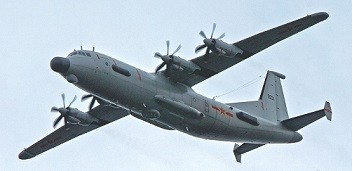The People's Liberation Army has made a major upgrade to its new electronic intelligence (ELINT) gathering aircraft, the Y-9JB, by equipping it with electronic reconnaissance capabilities, according to the Sina Military Network.
The Y-9JB, also known as the GX-8, which literally means the "High New 8," is the ELINT variant of the Shaanxi Y-9 mid-sized transport aircraft.
The Want China Times reported that the aircraft has significant advancements over China's first-generation electronic reconnaissance planes, the Y-8DZ or GX-2 and the Y-8G or GX-3.
According to the report, the electronic warfare aircraft has been developed by China for decades to improve the PLA's ability to gather and analyze operational and tactical electronic intelligence, and to to assist them in strategic decision-making.
To develop its first generation of electronic warfare aircraft, China relied on Soviet technology, specifically the Il-14, the Il-28 and the Tu-4, the report said. But majority of these aircraft were designed for the PLA Air Force and not for its Naval Air Force, which only began to install electronic reconnaissance systems in the 1980s.
In 2001, the PLA Naval Air Force has reportedly completed its first successful test flight of the Y-8DZ. The aircraft was regarded as a major step in the PLA's ELINT capabilities, as it is equipped with domestic systems that included computer controls, fully automated analysis and satellite distribution.
The report said, however, that there are issues with the Y-8DZ, which included outdated antennas and the lack of proper airlock, making it dependent on temporarily installed air conditioning equipment.
The PLA said that the Y-9JB has reportedly addressed the problems, as it has now has improved cabin pressurization and also a higher operational altitude to boost the coverage distance of its electronic systems. The new aircraft is now equipped with a 5,000-horsepower 6C turboprop engine with six-blade composite propeller to enhance its flight and handling performance.
The aircraft now has mounted four distinctive elongated antennas on its fuselage, replacing the old external antenna covers after it was removed from the aircraft, in addition to a prominent nose radar and satellite communications dome. According to the report, this enabled the Y-9JB to perform radar and communication signal reconnaissance missions with greater frequency coverage, a wider range and higher precision.
The report also identified several flaws of the Y-9JB, such as slow speed, a short flight range and relatively small space and load capacity, which may force the PLA Naval Air Force to develop bigger and more effective ELINT platforms by modifying large-sized planes like the Y-20 large military transport aircraft or the C-919 narrow-body twin-engine jet airliner.


